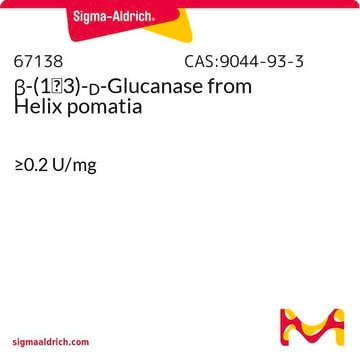V900511
Cellulase from Aspergillus niger
Vetec™, reagent grade
Synonym(s):
1,4-(1,3:1,4)-β-D-Glucan 4-glucanohydrolase
Sign Into View Organizational & Contract Pricing
All Photos(1)
About This Item
biological source
Aspergillus niger
grade
reagent grade
product line
Vetec™
form
solid
cellulase activity
≥0.3 units/mg solid
storage temp.
2-8°C
Looking for similar products? Visit Product Comparison Guide
Biochem/physiol Actions
Cellulase from Aspergillus niger catalyzes the hydrolysis of endo-1,4-β-D-glycosidic linkages in cellulose, lichenin, barley glucan, and the cellooligosaccharides cellotriose to cellohexaose. It does not cleave cellobiose or p-nitrophenyl-β-D-glucoside. This enzyme will also cleave intact glycosaminoglycan from a core peptide by hydrolyzing the xylosyl serine linkage.
Other Notes
View more information on enzymes for complex carbohydrate analysis at www.sigma-aldrich.com/enzymeexplorer
Legal Information
Vetec is a trademark of Merck KGaA, Darmstadt, Germany
Signal Word
Danger
Hazard Statements
Precautionary Statements
Hazard Classifications
Resp. Sens. 1
Storage Class Code
11 - Combustible Solids
WGK
WGK 1
Flash Point(F)
Not applicable
Flash Point(C)
Not applicable
Choose from one of the most recent versions:
Certificates of Analysis (COA)
Lot/Batch Number
Don't see the Right Version?
If you require a particular version, you can look up a specific certificate by the Lot or Batch number.
Already Own This Product?
Find documentation for the products that you have recently purchased in the Document Library.
Customers Also Viewed
Katherine J Mackenzie et al.
Journal of the American Chemical Society, 135(1), 293-300 (2012-12-29)
Here we report the construction and characterization of a recoverable, thermoresponsive polymer-endoglucanase bioconjugate that matches the activity of unmodified enzymes on insoluble cellulose substrates. Two copolymers exhibiting a thermoresponsive lower critical solution temperature (LCST) were created through the copolymerization of
Antonella Amore et al.
Microbial cell factories, 11, 164-164 (2012-12-27)
The use of lignocellulosic materials for second generation ethanol production would give several advantages such as minimizing the conflict between land use for food and fuel production, providing less expensive raw materials than conventional agricultural feedstock, allowing lower greenhouse gas
Wei Weiqi et al.
Bioresource technology, 128, 725-730 (2012-12-25)
Combination of liquid hot water pretreatment (LHWP) and wet disk milling (WDM) was investigated in this study to enhance the sugar recovery yield both in prehydrolyzate and enzymatic hydrolyzate. The results show that WDM with LHWP at 180 °C for
Mark A Currie et al.
The Journal of biological chemistry, 288(11), 7978-7985 (2013-01-24)
Clostridium thermocellum produces the prototypical cellulosome, a large multienzyme complex that efficiently hydrolyzes plant cell wall polysaccharides into fermentable sugars. This ability has garnered great interest in its potential application in biofuel production. The core non-catalytic scaffoldin subunit, CipA, bears
Margaret Buchanan et al.
BMC plant biology, 12, 235-235 (2012-12-13)
Endo-(1,4)-β-glucanase (cellulase) glycosyl hydrolase GH9 enzymes have been implicated in several aspects of cell wall metabolism in higher plants, including cellulose biosynthesis and degradation, modification of other wall polysaccharides that contain contiguous (1,4)-β-glucosyl residues, and wall loosening during cell elongation.
Our team of scientists has experience in all areas of research including Life Science, Material Science, Chemical Synthesis, Chromatography, Analytical and many others.
Contact Technical Service





